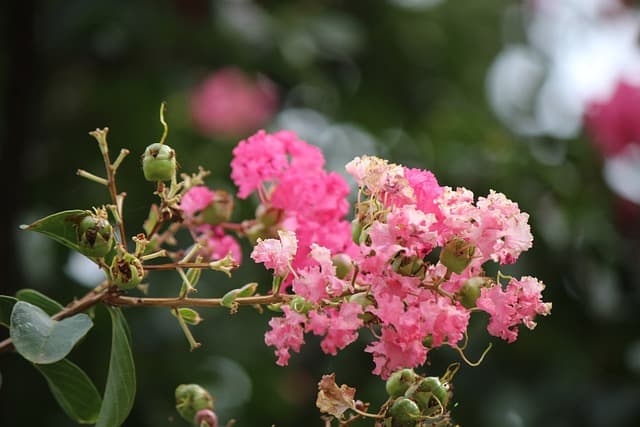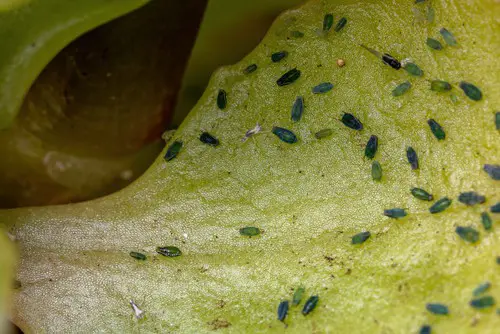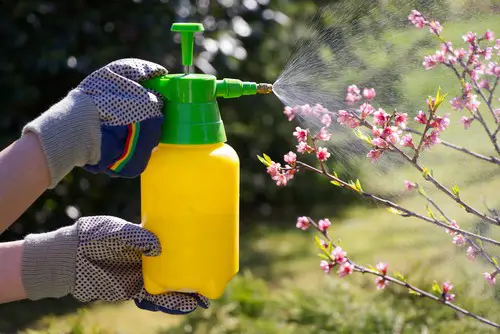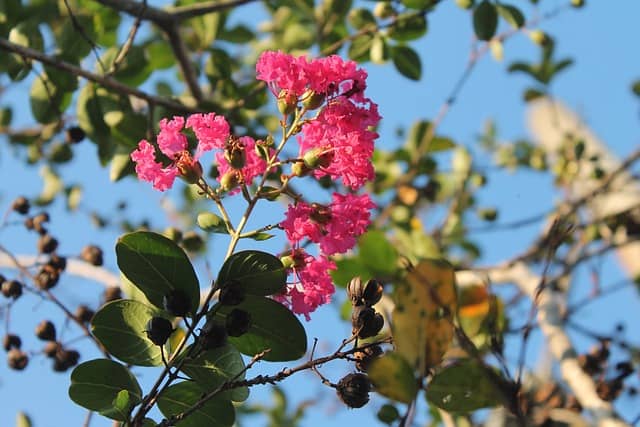Crepe myrtles are a popular choice for landscaping due to their beautiful blooms and hardiness. However, if you notice black spots on the leaves of your crepe myrtle, it could be a sign of a problem. While it may be alarming to see black spots on your beloved plant, it’s important to understand the causes and treatment options to keep it healthy.
Black spots on crepe myrtle leaves are often caused by a fungal disease known as sooty mold. This type of mold grows on the sugary substance called honeydew, which is produced by insects such as aphids, scales, and whiteflies that feed on the leaves.
The mold can reduce the plant’s ability to photosynthesize and weaken it over time, making it more susceptible to other diseases and pests.
Understanding the problem and the role of insects in causing black spots on crepe myrtle leaves is crucial in preventing and treating the issue. By taking preventative measures such as proper pruning, regular fertilization, and addressing any insect infestations, you can keep your crepe myrtle healthy and thriving.
In the following sections, we will dive deeper into the causes, signs, and treatment options for black spots on crepe myrtle leaves.
Key Takeaways
- Black spots on crepe myrtle leaves are often caused by a fungal disease known as sooty mold.
- Insects such as aphids, scales, and whiteflies that feed on the leaves produce honeydew, which attracts the mold.
- Preventative measures such as proper pruning, regular fertilization, and addressing any insect infestations can help keep your crepe myrtle healthy.
Don’t miss out on these other popular posts:
Understanding the Problem

Crepe myrtles are popular ornamental trees that are prized for their attractive flowers and foliage. However, they are susceptible to a number of diseases and pests that can cause serious damage to the plant. One of the most common problems affecting crepe myrtles is the development of black spots on the leaves.
Black spots on crepe myrtle leaves are a sign of a fungal disease known as Cercospora leaf spot. This disease is caused by the fungus Cercospora lythracearum, which attacks the leaves of crepe myrtle trees and shrubs.
The symptoms of this disease include small, circular spots on the leaves that gradually enlarge and turn black. In severe cases, the leaves may turn completely black and fall off the tree.
The development of black spots on crepe myrtle leaves is often associated with warm, humid weather conditions. The fungus that causes Cercospora leaf spot thrives in these conditions, and can quickly spread throughout the tree if not treated promptly.
In addition, the disease is often spread by splashing water, which can carry the fungal spores from one part of the tree to another.
To prevent the development of black spots on crepe myrtle leaves, it is important to take steps to maintain the health and vigor of the tree. This includes regular watering, fertilization, and pruning to remove dead or diseased branches.
In addition, it is important to avoid overhead watering, which can promote the spread of fungal diseases like Cercospora leaf spot.
If black spots do appear on crepe myrtle leaves, there are a number of treatment options available. These include the use of fungicides, which can help to control the spread of the disease, as well as cultural practices like pruning and watering that can help to prevent the development of black spots in the first place.
With proper care and attention, it is possible to keep crepe myrtles healthy and free from black spots on the leaves.
Causes of Black Spots
Crepe myrtle is a popular ornamental shrub that can be found in many gardens and landscapes. However, it is not immune to diseases and pests.
One of the most common problems that crepe myrtle owners face is the appearance of black spots on the leaves. These black spots can be caused by various factors, including fungi, pH, water, rain, light, and sunlight.
Fungi are one of the most common causes of black spots on crepe myrtle leaves. Fungal diseases such as cercospora leaf spot and cercospora lythracearum can cause black spots to appear on the leaves. These fungi thrive in warm, humid conditions and can spread quickly if left untreated.
In addition to fungi, pH levels can also contribute to the appearance of black spots on crepe myrtle leaves. If the soil pH is too low or too high, it can affect the plant’s ability to absorb nutrients and water, leading to black spots on the leaves.
Water is another factor that can contribute to the appearance of black spots on crepe myrtle leaves. Overwatering or underwatering can both cause stress to the plant, leading to black spots on the leaves.
Rain can also be a contributing factor to the appearance of black spots on crepe myrtle leaves. Heavy rainfall can cause the soil to become waterlogged, leading to root rot and other fungal diseases that can cause black spots to appear on the leaves.
Light and sunlight can also affect the appearance of black spots on crepe myrtle leaves. Too much or too little light can cause stress to the plant, leading to black spots on the leaves.
Role of Insects

Insects play a significant role in the development of black spots on crepe myrtle leaves. Many insects, such as aphids, scales, whiteflies, mealybugs, and Japanese beetles, are sap-sucking insects that feed on the leaves and stems of the crepe myrtle tree.
These insects pierce the plant’s tissue and suck out the sap, which weakens the tree and makes it more susceptible to disease and other insect problems.
Aphids, in particular, are a common insect problem for crepe myrtle trees. They are small, soft-bodied insects that come in a variety of colors, including green, yellow, and black. They feed on the sap of the leaves and produce a sticky substance called honeydew, which attracts ants and other insects.
Scales are another common insect problem for crepe myrtle trees. They are small, oval-shaped insects that attach themselves to the bark of the tree and feed on the sap.
They can be difficult to detect because they blend in with the bark and look like small bumps. If left untreated, scales can cause the bark to crack and peel, which can lead to more serious problems.
Whiteflies are another sap-sucking insect that can cause black spots on crepe myrtle leaves. They are tiny, white insects that feed on the underside of the leaves. Like aphids, they produce honeydew, which can attract ants and other insects.
Mealybugs are another common insect problem for crepe myrtle trees. They are small, soft-bodied insects that are covered in a white, powdery substance. They feed on the sap of the leaves and produce honeydew, which can attract ants and other insects.
Japanese beetles and Asian ambrosia beetles are other insects that can cause problems for crepe myrtle trees. Japanese beetles are metallic green heads that feed on the leaves and flowers of the tree, while Asian ambrosia beetles bore into the trunk and branches of the tree.
While insects can cause problems for crepe myrtle trees, there are also beneficial insects that can help control insect populations. Ladybugs, lacewings, and parasitic wasps are all beneficial insects that feed on sap-sucking insects like aphids and scales.
Encouraging the presence of these beneficial insects can help control insect populations and reduce the risk of black spots on crepe myrtle leaves.
Signs of Infestation
Crepe myrtle leaves are susceptible to infestations by various pests and diseases. One of the most common problems that crepe myrtle owners face is black spots on the leaves. Black spots are usually an indication of a fungal infection, and they can be caused by several different types of fungi. The most common culprits are sooty mold and black mold.
Sooty mold is a type of fungus that grows on the leaves of crepe myrtle trees. It appears as a black, powdery coating on the surface of the leaves. This fungus feeds on the honeydew that is secreted by aphids and other sap-sucking insects.
As the fungus grows, it can cover the entire leaf surface, causing it to turn black. In severe cases, the leaves may become distorted and yellow.
Black mold is another type of fungus that can cause black spots on crepe myrtle leaves. This fungus is also known as sooty black mold. Like sooty mold, it feeds on honeydew secreted by sap-sucking insects. The fungus appears as a black, velvety coating on the leaf surface. In severe cases, the leaves may become discolored and covered in white spots.
Infected leaves may also develop brown spots, stunted growth, curled edges, and other signs of damage. If left untreated, the fungus can cause defoliation, which can weaken the tree and make it more susceptible to other pests and diseases.
To prevent the spread of the fungus, it is important to pick off infected leaves as soon as they appear. Crepe myrtle owners should also avoid over-fertilizing their trees, as excess nitrogen can promote fungal growth. In severe cases, a fungicide may be necessary to control the infestation.
Preventive Measures

Preventing black spots on crepe myrtle leaves is the most effective way to avoid the problem altogether. Here are some preventive measures that can help:
1. Choose Resistant Varieties
Selecting resistant varieties is one of the most effective ways to prevent black spots on crepe myrtle leaves. Some varieties of crepe myrtle are naturally resistant to the disease. For example, the Natchez, Muskogee, and Catawba varieties are resistant to Cercospora leaf spot.
2. Plant in the Spring
Planting crepe myrtles in the spring can help them establish roots before the hot summer months. By planting in the spring, the trees will be better equipped to handle the stress of summer heat and humidity, which can make them more susceptible to disease.
3. Provide Good Air Circulation
Good air circulation is essential for preventing black spots on crepe myrtle leaves. Planting trees too close together or in an area with poor air circulation can create the perfect environment for the disease to take hold. Make sure to plant crepe myrtles in an area with good air circulation to prevent the disease from spreading.
4. Overwinter Properly
Overwintering crepe myrtles properly can also help prevent black spots on the leaves. Make sure to prune the trees in late winter or early spring to remove any dead or diseased branches. This will help prevent the disease from spreading to new growth.
5. Practice Sanitation
Practicing good sanitation is essential for preventing the disease from spreading. Remove any fallen leaves or debris from around the base of the tree, as this can harbor the disease. Also, make sure to sterilize pruning tools with rubbing alcohol before and after use to prevent the spread of disease.
6. Choose Irresistible Host Plants
Avoid planting crepe myrtles in areas where they are irresistible to pests. For example, planting crepe myrtles in the south, where they are a popular landscape plant, can attract pests like aphids, scales, and mealybugs, which can spread the disease.
7. Choose Hardy Trees with Moderate Growth Rates
Selecting hardy trees with moderate growth rates can also help prevent black spots on crepe myrtle leaves. Trees that are stressed or growing too quickly are more susceptible to disease. By selecting hardy trees with moderate growth rates, you can help prevent the disease from taking hold.
Treatment Options

There are several treatment options available for controlling black spots on crepe myrtle leaves. The choice of treatment depends on the severity of the infection and the cause of the black spots.
1. Fungicides
Fungicides are an effective way to control black spots caused by fungi. Thiophanate-methyl, myclobutanil, and chlorothalonil are commonly available fungicides that can be used to manage fungal infections. These fungicides work by inhibiting the growth of the fungus. Follow the instructions on the label to ensure safe and effective use.
2. Horticultural Oils
Horticultural oils like neem oil and other safe and effective horticultural oils can be used to control black spots on crepe myrtle leaves. These oils work by suffocating the insects that cause the black spots. They can also be used to control powdery mildew. Follow the instructions on the label for safe and effective use.
3. Baking Soda Spray
A baking soda spray is a natural and safe way to control black spots caused by fungi. Mix one tablespoon of baking soda with one gallon of water and spray the solution on the affected leaves. The baking soda spray works by altering the pH level of the leaf surface, making it difficult for the fungus to grow.
4. Controlling Insects
Insects like aphids, bark scales, whiteflies, and mealybugs can cause black spots on crepe myrtle leaves. Insecticides and insecticidal soaps can be used to control these insects. Always follow the instructions on the label for safe and effective use.
5. Fertilizer
Fertilizing crepe myrtle trees can help prevent black spots caused by nutrient deficiencies. Use a balanced fertilizer with equal amounts of nitrogen, phosphorus, and potassium. Apply the fertilizer according to the instructions on the label.
6. Overhead Irrigation
Overhead irrigation can contribute to the growth of fungi that cause black spots on crepe myrtle leaves. Instead, water the trees at the base to avoid wetting the leaves. This will help prevent the growth of fungi.
Post Treatment Care
After treating the black spots on crepe myrtle leaves, it is important to take proper care of the plant to prevent a recurrence of the problem. Here are some post-treatment care tips:
1. Watering and Irrigation
Watering is an essential aspect of post-treatment care. It is important to ensure that the plant gets enough water, but not too much. Overwatering can lead to root rot, which can further damage the plant. It is recommended to water the plant deeply and infrequently, and avoid overhead irrigation to prevent the spread of fungal spores.
2. Pruning and Debris Removal
Pruning and removing debris from around the plant can help improve air circulation and reduce humidity, which can prevent the growth of fungi. It is important to remove any infected leaves or branches and dispose of them properly, away from the plant.
3. Follow Label Directions
It is important to follow the label directions of any fungicides or other treatments used to treat the black spots on crepe myrtle leaves. Overuse or misuse of these products can harm the plant and the environment.
4. Nitrogen and Energy

Providing the plant with the right amount of nitrogen and energy can help improve its overall health and resistance to diseases. It is recommended to avoid over-fertilizing the plant, as this can lead to excessive growth and reduce the plant’s ability to produce chlorophyll and flower buds.
5. Upper Surface Cleaning
Cleaning the upper surface of the leaves can help remove any remaining fungal spores and prevent the growth of new ones. This can be done using a soft cloth or brush, or by spraying the plant with water.
Frequently Asked Questions
How to get rid of black fungus on crepe myrtles?
To get rid of black fungus on crepe myrtles, one should remove the insects that are producing the honeydew that the fungus grows on. This can be done by washing the leaves with a strong stream of water or using insecticidal soap. Once the insects are gone, the fungus will eventually disappear as well.
How to prevent sooty mold on crepe myrtles?
To prevent sooty mold on crepe myrtles, one should control the insects that produce the honeydew that the fungus grows on. This can be done by regularly inspecting the plant for insects and using insecticidal soap or other insecticides as needed. Additionally, pruning the plant to allow more air circulation can help prevent the growth of sooty mold.
Best fungicide for crepe myrtle?
The best fungicide for crepe myrtle depends on the specific disease or fungus that is affecting the plant. Some common fungicides for crepe myrtle include copper fungicides, chlorothalonil, and myclobutanil. It is important to carefully read and follow the instructions on the fungicide label to ensure safe and effective use.
How do you treat black fungus on crepe myrtles?
To treat black fungus on crepe myrtles, one should first remove the insects that are producing the honeydew that the fungus grows on. This can be done by washing the leaves with a strong stream of water or using insecticidal soap. Once the insects are gone, a fungicide may be applied to the plant to help eliminate the fungus.
How do you treat Cercospora leaf spots on crepe myrtles?
To treat Cercospora leaf spots on crepe myrtles, one should remove any infected leaves from the plant and dispose of them. A fungicide may also be applied to the plant to help prevent the spread of the disease. It is important to carefully read and follow the instructions on the fungicide label to ensure safe and effective use.
What are the dark spots on crepe myrtle leaves?
The dark spots on crepe myrtle leaves may be caused by a number of different factors, including fungal diseases such as Cercospora leaf spot or powdery mildew, or insect infestations such as aphids or scales. It is important to properly identify the cause of the dark spots in order to effectively treat the problem.

Hey, I’m Lisa and I’ve been an avid gardener for over 30 years. I love writing, talking and living in the garden! Feel free to connect with me on my socials below


